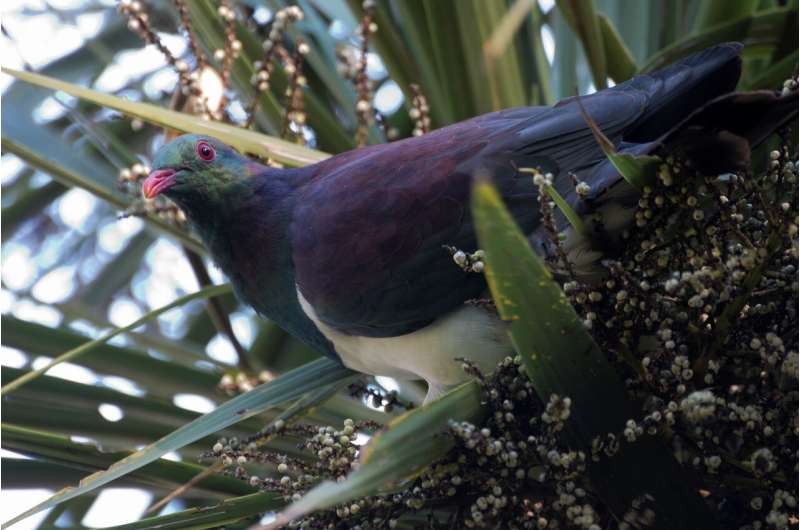Predators kill kererū, but it's lack of food that stops them bouncing back

Historically, kererū (Hemiphaga novaeseelandiae) used to occur in massive flocks that numbered hundreds of birds. But over the past 200 years, numbers have declined rapidly due to habitat loss and predation by introduced mammals. To what extent are these factors still affecting kererū today? A team of researchers from Manaaki Whenua, led by Dr. Jo Carpenter, gathered and analyzed data from three different sources to find out. The results have just been published in the New Zealand Journal of Ecology.
First, Dr. Anne Schlesselmann collated data from studies that had observed kererū nests. Across the 397 nests monitored in those studies, most failed due to predation by ship rats, possums and stoats. "To my surprise, most eggs in fact never even had a chance to hatch before they were eaten by ship rats or possums," commented Dr. Schlesselmann.
Second, Dr. Rachelle Binny analyzed a dataset of kererū observations collected from 11 sanctuary sites to test the hypothesis that fenced sanctuaries, such as Maungatautari or Orokonui, which have eradicated most pests, would result in increased numbers of kererū being observed. While kererū did increase at a few sites, the sanctuaries that had eradicated rats, possums, and stoats did not have obviously better outcomes for kererū than unfenced sanctuaries. Many of these sanctuaries only encompass small areas of forest, and it is possible they do not have enough habitat to sustain high numbers of kererū once pests are controlled. "This work demonstrates how important food and forest are to kererū, as well as whether there are pests. Controlling pests in areas with very little suitable kererū habitat is unlikely to result in more kererū," said Dr. Binny.
Third, the team wanted to get a nationwide picture of the factors that influence where kererū are found. Dr. Susan Walker analyzed the 1969-1979 and 1999-2004 results from the Bird Atlas of New Zealand, to see how kererū distribution related to environmental factors such as road density and forest cover. The Bird Atlas collated data collected by birders and citizen scientists over several years in an effort to sample the whole of the country.
By comparing records from the 70s with the later records, the team showed that kererū distribution was closely related to the amount of intact forest available, although kererū also occurred in urban areas, where the wide range of plants probably provide them with more food. They also showed that kererū declined between the two time periods in the South Island, but not the North Island. Currently, keen birders are recording bird sightings across the country for the 2019-2024 Bird Atlas of New Zealand. "The results from that effort will be really important in understanding whether kererū are still declining in parts of Aotearoa," said Dr. Carpenter.
Dr. Carpenter summed up the study's findings. "Overall, the results showed that mammalian pests such as possums and ship rats suppress kererū within forests. However, our findings also highlighted the importance of forest area and food supply for kererū recovery. Kererū are one the world's largest pigeons, so they need a diverse range of high-quality food throughout the year to thrive."
More information: Factors limiting kererū (Hemiphaga novaeseelandiae) populations across New Zealand. New Zealand Journal of Ecology45(2): 3441 DOI: dx.doi.org/10.20421/nzjecol.45.30
Provided by Manaaki Whenua - Landcare Research















